And then in the summer of 2007, came the big one, the juicy main course for which everything else in my life had been nothing but a starter. Aonghus’ empire had reached Sheffield, formerly famous for its steel works and latterly for the ‘Full Monty’ film. It was beginning to rise again after the destruction of the steel industry and Aonghus was on the spot. An extraordinary building of interlocking dodecahedrons clad in copper, was rising like some phoenix in a drab industrial courtyard, kitchen, canteen and meeting room for Ruskin Mill’s Freeman College. I was commissioned to create seven windows on the theme of the ‘Life Processes’ for the College. I travelled up a few times and took part in a special medical seminar organised by Dr James Dyson, one of Britain’s leading exponents of Anthroposophic Medicine. I did some writing on the whole process and shall include it in its entirety. There are few bits of history and process that I have said before, but bear with me, they need to be said again for the sake of completeness.
The Seven Life Processes
The seven life processes are ‘dynamic’ activities within the ‘Life body’ or Etheric of man. They constitute a sustaining, growing, self-perpetuating flow of activity. These processes are: Breathing-Warming-Nutrition-Secretion-Maintenance-Growing and Propagation.
My original sketches were based on the work of Karl König (A Living Physiology), who aligns these seven life processes with cosmic evolutionary developments, the idea being that, just as human beings reincarnate, (take on new existence), the earth itself has various distinct embodiments. Each condition is the cosmic/karmic consequence of a former one. This ancient piece of wisdom is inscribed in the sequence of the days of the week. Thus Saturday, the first day in this sequence, is an echo of the original Saturn state, Sunday refers to the sun, Monday to the moon, etc.
Rudolf Steiner gives a series of seven colours for these planetary aspects of the days of the week. Thus, Saturday is blue, Sunday white, Monday purple, Tuesday red, Wednesday yellow, Thursday orange and Friday green. In 1991 I completed a Zodiac fanlight in Ruskin Mill using this colour sequence and borrowing the forms of the planets from the capitols of the first Goetheanum.
The Shift
After the completion of the first series of sketches it was strongly felt (by the medical study group informed by Dr James Dyson) that the sequence should be based not on the macrocosmic evolutionary process, but on microcosmic human development alone. This meant a radical rethink in terms of colour and form, but also the possible ‘shining through’ of the one into the other. The microcosmic sequence shows the heavenly bodies as they were perceived before Copernicus, a geocentric view, placing the sun sphere as the fulcrum between the inner and the outer planets. It thus has the same relationship to the planets as the human heart has to the rest of the human organism.
The Forms
As a teenager I immersed myself very strongly in Culpeper’s Herbalism. Nicholas Culpeper (1616-1654) one of the greatest British Herbalists, probably inspired by Rosicrucian alchemy, created a whole body of healing that related planetary and Zodiac forces with the properties of plants. Plant families, according to this system, were under the rulership of cosmic forces and embodied the ‘nature’ of their influence in their structure, colouration and virtue. After much practice I was eventually able to intuit a particular planetary force that ruled a plant with a great deal of accuracy. Seeing the seals of the seven planets in their respective metals at the Goetheanum was an extension of this contemplative process.
Another important input into the forms was Bernard Lievegoed’s (1905-1992) descriptions of the planetary workings within the organs and processes of the human body.
Colours
A shift from evolutionary to human developmental processes necessitated a shift in colour.
I had already experimented with using the complementary colours in the original zodiac fanlight and now deepened and intensified this process. The complementary addition to the ‘pure monochrome’ of each panel was further enhanced by the presence of the so-called anti-life processes or counter-life processes. Thus, each panel (except the central sun one) includes a counter-life process, a kind of negative shadow, where the life process has been corrupted by one or other of the adversary powers, Lucifer and Ahriman. My ‘colour journey’ began with the central window, embodying the sun, the life process of secretion and the Representative of Man.
Sun; white, red and black
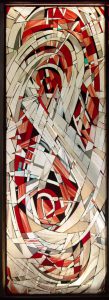
I wanted this window to be somewhat set apart and yet carry the essence of all the others. As a young child, I attended the children’s services, non-denominational services devised by Rudolf Steiner for the Waldorf Schools. Thick red velvet curtains had been drawn across the windows and the sunlight penetrating through into the room bathed the space in deep redness, added to which the altar cloth was red, the candles (white wax) cast a golden glow and the black clothes of the service holders created a sombre contrast .White red and black represent the primary colours of our humanity. Our essential three-foldness is represented in them: white for our spirit, black for the body and red for our soul that weaves in between. They are also the colours of the rose cross. If colour is taken towards light, it eventually becomes white. If colour condenses itself it eventually becomes black. Thus, in its expanding and contracting nature, the central window defines a process that informs all the others.
Mars; red and green
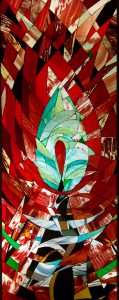
The red element expands and intensifies itself in the Nutrition/Mars window. Interestingly, the interlocking drop form (represented upside down), can be found in the Mars column of the first Goetheanum. This form arose by chance without deliberation on my part. The red is broken up by scratches of white where the glass has been etched. A flame shaped green pool surrounds the new substance created through nutrition. A black, steeply rising pyramid represents the counter-life-process of hardening.
Venus; red and green
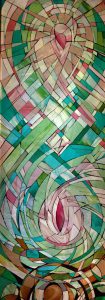
The red element extends itself to the left of the sun becoming pink as it feminises itself in Venus. As Mars on one level is all force, activity, will, masculinity, Venus is receptivity, hidden activity behind the scenes femininity. The green, which was a self-contained pool in Mars,weaves and flows throughout the whole window in Venus. The self-encapsulating form at the base showing the counter-life process of cystation is brown, a mingling of red and green.
Jupiter; blue and orange

In the next complementary pair there is both a lightening and deepening of colour. The red moves into orange and the green deepens into blue. This is my most radical shift from the original colours given by Rudolf Steiner for the planets and the days of the week. The orange of Jupiter is retained but surrounded by a deep blue; the lemon yellow of Mercury has given way to streaming orange and pale blue. The more or less symmetrical flame (Jupiter is the planet of symmetry) is held in a kind of crucible. The transition between the dark blue and orange is brought about by the golden/brown glass stippled with silver nitrate. The counter-life process of combustion at the bottom is shown like a kind of explosion, the orange almost becoming red again.
Mercury; orange and blue
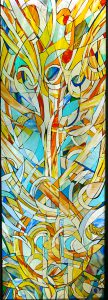
This is the only window which has a hidden reference to a known symbol, the staff or caduceus of Mercury, the Messenger of the Gods. The flame that was held so serenely in the blue background of Jupiter has become a vigorous, almost chaotic current in the Mercury. Growth is pictured spurting at the top and the anti-life process is both contained in the whole image and focussed at the bottom. The anti-life process is premature ripening, rotting and disintegrating. In Mercury a fine balance between activity and chaos is addressed.
Saturn; purple and yellow
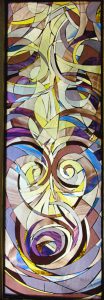
The intensification of the colour reaches its outer limit with Saturn and Moon. The orange of Jupiter has lightened into lemon yellow. The vortex of the anti-life process and the rhythmic engulfing forms surrounding the yellow are red purple, the so-called Rot Violet. This colour contains the warmth element of Old Saturn and pays tribute to it. Breathing in this sense is a rhythmic relationship with the outer world – a give and take, an inhalation of sense impressions and an exhalation in gratitude to the sustaining outer world. The vortex is an image of extreme one-sided, neediness or consuming.
Moon; yellow and purple
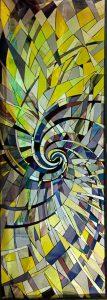
In the final panel which is the complement of Saturn, the purple goes towards the blue rather than the red. This was an aesthetic decision more than anything else, as the colour needed to blend with both the orange of the Mercury panel and the pink and green of Venus. In the Generation moon panel, the yellow does not ascend and descend but is dispersed towards the periphery by the purple spirals in the middle. The anti-life process of replication is shown by a kind of grid or cellular structure. As in the Mercury panel it weaves throughout and is not concentrated at the base.
Colours and Metals
A particularly satisfying element in stained glass (very relevant for this particular project) is that the colours inherent in the glass have been created through the use of very specific metals. The ancients had a wisdom that saw the workings of heavenly planetary forces in physical substance. The Aztecs, for example, called gold ‘the blood of the sun’. Rudolf Steiner’s insights extend the subtle relationships between matter and energy. Thus, gold is linked with the sun, silver with the moon, copper with Venus, quicksilver with Mercury, tin with Jupiter and lead with Saturn. The colour in glass is created in two ways, either with the addition of metallic oxides or with the suspension of actual metallic particles within the glass. Thus, gold particles create a very beautiful ruby red and selenium yellow and orange. Iron and copper oxide creates green, and cobalt blue. Silver nitrate as previously mentioned creates the warm golds and browns in the Jupiter/warming panel. Lead and tin are present in the outer construction of each panel in the protecting frame.
The Student’s Journey
The transition from Paganism to Christianity in Russia was largely affected (so the story goes) by one single event. Prince Vladimir of Kiev (tenth century) of Viking origins, sent envoys to Constantinople to get a taste of the ‘New Religion’. They were led into the Hagia Sophia, the greatest temple of Christendom, and were overwhelmed by the sheer beauty. It was this Greek element, the utilisation of beauty as a spiritualising force that shook the foundations of their souls and ultimately led to Russia’s conversion. Text books often describe churches as narrative structures, ways in which the Bible story could be imparted to a largely illiterate society. But perhaps of far greater importance was the context they created, a living environment that embodied a taste of heaven, of paradise. The so-called common people lived in hovels, mud and wattle shacks, without windows and chimneys, in which cattle were accommodated in the winter months.
Going into a church, and even more so, a cathedral, must have been like stepping into another world, a world of colour, music, form, beauty and richness that transported them from daily squalor into the forecourt of the divine. Today art has largely lost this function; our society is defined by its technology and not through its art. Art and artistic activity has been marginalised, thrust out of the cultural mainstream. Many modern works of art derive their only significance from the context of a gallery and through the intentions of the artist. Beauty, and indeed its two other accompanying archetypes, wisdom and goodness, are seen as entirely relative.
What is exciting about the windows and the sculptures in the Freeman College’s new build, is that they have a context, were created for a purpose. The intention of the artists goes beyond the purely subjective, to the shaping of an environment that embodies certain collective ideals and higher perspectives. So just as the ideal of beauty, the total environment created in the medieval church or cathedral had a ‘rub off’ effect, these objects, e.g. the windows and sculptures may nudge the student into harmony with a certain process of development. This process of development can be described as The Student’s Journey. The journey has been worked out according to certain very definite thresholds and is based on the Life Processes. The student’s journey is a path of guidance, development and eventual independence.
The first of these steps or gateways is the life process known as breathing. This is not so much an activity of the lungs as the relationship the individual has with the world. We breathe through our senses; we create a relationship with the outer world, with each other. This is one of give and take that is social as well as creative. The student enters into a relationship with others, feels that he belongs. Thus, this first step on the journey is a sense of belonging. Each life process has a negative or shadow side, which could be described as an anti-life- process or a counter life process. Thus, the shadow side of breathing is consuming. This is a state of neediness and insecurity which seeks to fill a kind of emotional void by sucking in or gobbling up the other. Nowadays human beings have been defined as consumers, passive vacuum cleaners that suck in the objects of the world. No creative input is expected: I shop therefore I am. This is an entirely negative view of humanity, which denies that essentially human element of give and take, of reciprocity.
Warming—Jupiter
Fire is the primal tool, that which separates the human from the natural world. The window shows a bright flame held in a kind of crucible or chalice. By making a fire in the dark forest we can feel safe in the world. We might glimpse the eyes of the night beasts but we are warm and secure. By entering into the body of an organisation, e.g. Freeman College, the student needs to adapt, adjust: perhaps certain strong individualising tendencies need to be modified. Inception into a structure implies adaptability. Without organisational knowledge no learning can take place. The downside of adaptation becomes collusion and a consequent loss of identity. This is the counter-life-process that leads inevitable to combustion. From the moment we wake to the moment we go to sleep, total conformity is expected of us. The human domestic animals, homogenised, manipulated and de-educated, are supposed to shuffle through life en masse, bleating or being silent when we are told. This uncomfortable state of affairs, this annihilation of identity, leads to outbursts of violence, to a deep-seated rage, spontaneous and not directed at anyone in particular.
Nourishing—Mars
With this third gateway, the outer truly becomes the inner. Food substance taken into the body is destroyed before its etheric/cosmic counterpart can be built into the body. Rudolf Steiner describes that through eating, material substance is actually unmade, a process probably similar to a nuclear reaction. The red Mars window shows a kind of green flame within which there is a red dot. Substance has jumped the gap, passed from outside to inside. The guidance and skill imparted to the student has become internalised. It is a bit like learning to ride a bicycle or drive a car. At first, these abilities are seen as separate, external, alien. Eventually they become an integral part of self. Even if one has not ridden a bicycle for thirty years, one can do so again with comparatively little effort. The imparted skills become the individualised skills, competence gives empowerment. The relationship that the things of the outer world have to each other becomes meaningful, clay to pottery, sheep to wool, and the transformation of raw material by human effort and skill. The counter-life process to nourishing is hardening. We can see this hardening process in our physical bodies: arthritis, stones, hardening of the arteries and Alzheimer’s are all forms of hardening. In terms of the student’s journey, this hardening could be described as getting stuck. The self identifies itself too strongly, too prematurely with one or other activity, becomes fixated, embeds itself in the security of the known, at the cost of further development.
Secretion—Sun
The central window holds the balance, is a fulcrum between outer planets and inner planets; it is untouched, uncorrupted by the adversary powers. In this sense, it represents the Christ who truly addresses the human self and awakens to responsibility. Entering this gateway, the student awakens to his purpose, his sense of vocation. Guidance and skill has led to discrimination and discernment. As human beings we have freedom of choice and with choice comes responsibility. We might experience that ‘aha!’ moment, a flash in which we realise what we are here for, the purpose of our lives. On a slightly less profound level, we choose certain types of work over and against others. I would like to be a gardener, not a brain surgeon, etc.
Maintaining—Venus
The force of Mars gives way to the more enabling power of Venus. The red has become pink and the little green pool has spread itself into an all-pervading colour. The next challenge of the student is to take his new-found sense of self, of vocation into the community, not yet the greater community of the world, but the community of his fellows: to maintain the strength and momentum amongst the difficulties and distractions. This can only be achieved in a context, a context that is mutually sustainable. Those experiences and skills that we have worked for have a place, are sustained by the community around us. Our offerings as individuals are maintained by the context in which we find ourselves. It is no use selling sand in the Sahara, they have plenty. The counter-life process in Mars can be seen as a hardening, a hardening of the self within itself. The counter-life process in Venus is encapsulation. The self isolates itself from others, digs in as it were, and becomes an elitist, stubbornly clinging to its perceived task and denying the flow, interchange and the interdependence that we all have with others. Organically this condition is cancer; the maintaining energies of the organism are interrupted, cells take on an abnormal independent life which threatens the welfare of the whole. The super-rich enshrine themselves in gated strongholds while the rest of the world goes to the dogs. In collaboration we can save each other and ourselves.
Growing—Mercury
Maintaining moves into the sphere of growth, the student becomes good at what he does; healthy, steady development takes place. He is given new tasks, new challenges, is on the way to becoming a master. This steady growth in skill and maturity is dependent on a recognition of a person’s potential, that which has not yet developed but will eventually flower. A person engaged in whatever activity becomes better at it, wins recognition for himself, is promoted. True promotion is affected when the higher potential of the other is recognised. It depends on the power of interpersonal transformation. Our economic slump is a fine example of the counter-life force, a disintegration, premature ripening before maturity is achieved. Money takes on an independent, imaginary life which appears to grow indefinitely. Suddenly it turns out to be fool’s gold and the whole system comes crashing down. On a human level, a too rapid growth, the meteoric rise to fame of the celebrity culture, often leads to a fall, a plunge into ordinariness, dissatisfaction and despair. It is in relationship with others that our true worth is realised.
Generation—Moon
The seventh window completes the journey. The student is now ready to enter the world and maintain his sense of autonomy. What I am can exist within a greater social network. Generation can also be understood as regeneration, continuous reinvention, an essentially creative condition. New, fresh ideas should lead one ever onwards. The counter-life force or negative shadow is replication, appropriate on a cellular level but not as a model for society. Our sense of uniqueness, of individuality is endlessly challenged by the replications of our world. Mass production, electronic gadgetry, branding, cloning etc. is entirely based on repetitions of repetitions. As individuals, we struggle to uphold the original, to maintain our independence in the vast, endlessly chugging machinery of society.
Having worked with these ideas for a little while, I will dare to add a personal inspiration. If one thinks of these planetary life processes not only as polarities but as complementary couples, one can perhaps see them in a new relationship to each other. The Breathing of Saturn can be seen as renewing. Through breathing we renew ourselves. Renewal balances the counter-life process in the moon panel. Replication is transformed into inspiration. Generation or reproduction of the moon panel can be seen as creativity and transforms the passive consumerism of Saturn. The warming of the Jupiter window is a process of nurturing, like the slow hatching out of an egg. It counters the decaying and rotting tendencies of the counter-life process of Mercury. Seeing and recognising the higher potential of the other, the interpersonal element of Mercury transforms the negative combustive tendencies of Jupiter. The self is not annihilated in conformity, expressing itself in mindless rage, but is acknowledged and celebrated. Nutrition in the Mars window can be seen as continuous development, a development that is utterly dependant on the presence of others. Thus, it counters the negative encapsulating tendencies of Venus. We cannot be self-sufficient elitists in the knowledge that our development is intimately interwoven with others. The maintaining ability of Venus can also be seen as the enabling power of the community. Through the enabling power of a community, the hardening tendencies of the Mars negative aspect, retardation, are transformed. Thus, one can see the seven life processes and the whole student’s journey not only as a linear progression but as a circle with the sun as its centre. The Sun self, Christ or the Representative of Man permeates the imbalances inherent in the counter-life processes and transforms them.

Concept to Object
Much of the current redundancy experienced by the artist of today is due to a lack of function. In former times the artist served, to a greater or lesser extent, the needs of the community. Those needs were primarily religious. His creations were re-creations of a collectively held mythology or ideology. In my own life I have moved strongly from the things I wanted to say, to express, to the things that needed to be expressed. I was guided on this journey by having to learn various crafts; mosaic, glass, stone and gardening.
A craftsman reaches out to the material, allows it to speak; is essentially a collaborator, not a dictator. The material itself becomes a vehicle of expression. The more I worked with the various materials, the less I had to say. It was almost as if becoming a craftsman silenced me. At first this was a somewhat worrying trait, but then I realised that my skills (won under great duress) could be put to the service of others, as a teacher, but also as a vehicle for defining the values of communities, the greater good. Thus (on my better days) I see myself as a channel through which higher ideals can be realised.
Commissions, though often challenging, provide me with the basis of further work, further development. They thrust me into spheres that my natural tendencies as an artist might never have penetrated. Thus, it was with the Freeman windows. When I began, the notion of the seven life processes was only a concept, somebody else’s idea. Through reading, discussion and contemplation, these concepts became an artistic process. The scale wax drawings are an expression of this artistic process. They were drawn horizontally on a large table, engaging me in quite another way than if they had been vertical, up against a wall. I could dance around them, each colour gesture a natural extension of a bodily movement.
This freely flowing artistic process, executed in coloured beeswax crayons had then to be honed down and teased into a form that could be made in glass. I took a rough tracing of the dynamic movements and then worked out a line drawing. The coloured surfaces or planes disappeared, and boundary lines were put in their place. These were determined by the gesture of each panel but also by the limitations that glass cutting imposes. Lines were added and taken away, the dynamic colour movements of the drawings were reduced to linear skeletons. Once this had been achieved, I took another couple of tracings (accurate ones) making the so-called cut line and the templates. The cut line is the sheet of tracing paper, resting on the light box onto which the coloured pieces of glass are placed. Each single piece of glass is cut out using theses templates. The size of each template is reduced by a millimetre or so around each edge, allowing for a gap around each piece of glass. In traditional stained glass, this gap (somewhat wider) would be occupied by lead.
The lamination technique (which I developed) does not require lead and allows a freer, more spontaneous use of glass. Smaller, odd shaped pieces can be incorporated; there is a greater sense of movement and rhythm. The various colours of each complementary pair of panels were placed on a shelf along the window. Thus, although I used electricity to illuminate the cut-out pieces, I always had a daylight impression of each colour. The colour drawings, the linear plans and the cut out coloured glass I treated as distinct, slightly separate processes. The colour sketch gives an impression of how the window will be but, is not a blue print. An important quality in glass work (for me, anyway) is freshness, keeping it alive right to the end.
Glass is very hard, brittle and immovable, and needs to be enlivened by continuous creativity. Otherwise it will impose itself on the maker, locking him into a slick, rather predictable product. I tried to use the coloured glass like paint, adding little flecks here and there to enhance or tone down other colours. Once the glass was cut, it was moved off the light box onto the original plan and reassembled, glued onto a backing plate and then a further plate of textured glass was placed behind it. This acts as a diffuser, giving the panel a flowing, watery quality. Rigidity and movement are the two qualities of glass that I sought to enhance. In the front, the coloured glass mosaic shows the crystalline nature of glass. The backing plates, catching the light, diffusing and rippling, show its liquid aspect.
Thus my journey was one which can be described as a ‘Descent into Matter’(to mimic a much-used term). Concepts are enlivened through an artistic process and are then realised in the material. A journey from concept to object has been completed.
